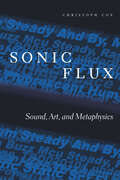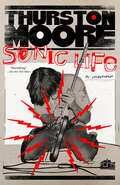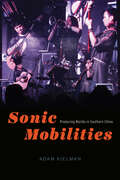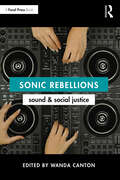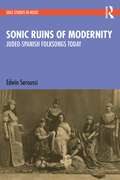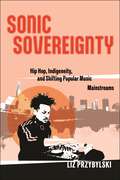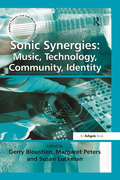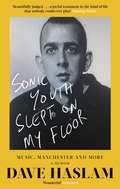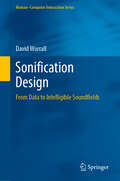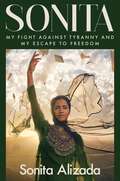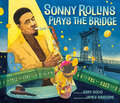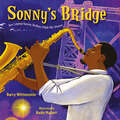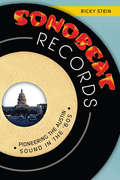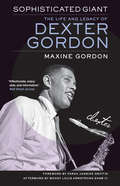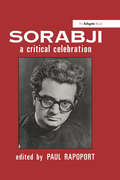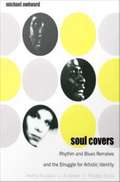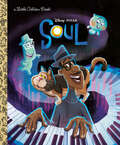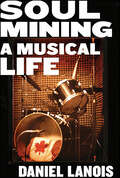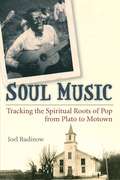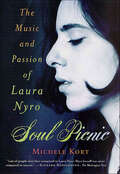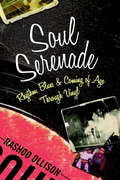- Table View
- List View
Sonic Flux: Sound, Art, and Metaphysics
by Christoph CoxFrom Edison’s invention of the phonograph through contemporary field recording and sound installation, artists have become attracted to those domains against which music has always defined itself: noise, silence, and environmental sound. Christoph Cox argues that these developments in the sonic arts are not only aesthetically but also philosophically significant, revealing sound to be a continuous material flow to which human expressions contribute but which precedes and exceeds those expressions. Cox shows how, over the course of the twentieth and twenty-first centuries, philosophers and sonic artists have explored this “sonic flux.” Through the philosophical analysis of works by John Cage, Maryanne Amacher, Max Neuhaus, Christian Marclay, and many others, Sonic Flux contributes to the development of a materialist metaphysics and poses a challenge to the prevailing positions in cultural theory, proposing a realist and materialist aesthetics able to account not only for sonic art but for artistic production in general.
Sonic Interactions in Virtual Environments (Human–Computer Interaction Series)
by Stefania Serafin Michele GeronazzoThis open access book tackles the design of 3D spatial interactions in an audio-centered and audio-first perspective, providing the fundamental notions related to the creation and evaluation of immersive sonic experiences. The key elements that enhance the sensation of place in a virtual environment (VE) are:Immersive audio: the computational aspects of the acoustical-space properties of Virutal Reality (VR) technologies Sonic interaction: the human-computer interplay through auditory feedback in VEVR systems: naturally support multimodal integration, impacting different application domainsSonic Interactions in Virtual Environments will feature state-of-the-art research on real-time auralization, sonic interaction design in VR, quality of the experience in multimodal scenarios, and applications. Contributors and editors include interdisciplinary experts from the fields of computer science, engineering, acoustics, psychology, design, humanities, and beyond. Their mission is to shape an emerging new field of study at the intersection of sonic interaction design and immersive media, embracing an archipelago of existing research spread in different audio communities and to increase among the VR communities, researchers, and practitioners, the awareness of the importance of sonic elements when designing immersive environments.
Sonic Life: A Memoir
by Thurston MooreFrom the founding member of Sonic Youth, a passionate memoir tracing the author's life and art—from his teen years as a music obsessive in small-town Connecticut, to the formation of his legendary rock group, to thirty years of creation, experimentation, and wonder"Downtown scientists rejoice! For Thurston Moore has unearthed the missing links, the sacred texts, the forgotten stories, and the secret maps of the lost golden age. This is history—scuffed, slightly bent, plenty noisy, and indispensable." —Colson Whitehead, Pulitzer Prize–winning author of The Underground Railroad and Harlem Shuffle Thurston Moore moved to Manhattan&’s East Village in 1978 with a yearning for music. He wanted to be immersed in downtown New York&’s sights and sounds—the feral energy of its nightclubs, the angular roar of its bands, the magnetic personalities within its orbit. But more than anything, he wanted to make music—to create indelible sounds that would move, provoke, and inspire.His dream came to life in 1981 with the formation of Sonic Youth, a band Moore cofounded with Kim Gordon and Lee Ranaldo. Sonic Youth became a fixture in New York&’s burgeoning No Wave scene—an avant-garde collision of art and sound, poetry and punk. The band would evolve from critical darlings to commercial heavyweights, headlining festivals around the globe while helping introduce listeners to such artists as Nirvana, Hole, and Pavement, and playing alongside such icons as Neil Young and Iggy Pop. Through it all, Moore maintained an unwavering love of music: the new, the unheralded, the challenging, the irresistible.In the spirit of Just Kids, Sonic Life offers a window into the trajectory of a celebrated artist and a tribute to an era of explosive creativity. It presents a firsthand account of New York in a defining cultural moment, a history of alternative rock as it was birthed and came to dominate airwaves, and a love letter to music, whatever the form. This is a story for anyone who has ever felt touched by sound—who knows the way the right song at the right moment can change the course of a life.
Sonic Mobilities: Producing Worlds in Southern China (Chicago Studies in Ethnomusicology)
by Adam KielmanA fascinating look at how the popular musical culture of Guangzhou expresses the city’s unique cosmopolitanism. Guangzhou is a large Chinese city like many others. With a booming economy and abundant job opportunities, it has become a magnet for rural citizens seeking better job prospects as well as global corporations hoping to gain a foothold in one of the world’s largest economies. This openness and energy have led to a thriving popular music scene that is every bit the equal of Beijing’s. But the musical culture of Guangzhou expresses the city’s unique cosmopolitanism. A port city that once played a key role in China’s maritime Silk Road, Guangzhou has long been an international hub. Now, new migrants to the city are incorporating diverse Chinese folk traditions into the musical tapestry. In Sonic Mobilities, ethnomusicologist Adam Kielman takes a deep dive into Guangzhou's music scene through two bands, Wanju Chuanzhang (Toy Captain) and Mabang (Caravan), that express ties to their rural homelands and small-town roots while forging new cosmopolitan musical connections. These bands make music that captures the intersection of the global and local that has come to define Guangzhou, for example by writing songs with a popular Jamaican reggae beat and lyrics in their distinct regional dialects mostly incomprehensible to their audiences. These bands create a sound both instantly recognizable and totally foreign, international and hyper-local. This juxtaposition, Kielman argues, is an apt expression of the demographic, geographic, and political shifts underway in Guangzhou and across the country. Bridging ethnomusicology, popular music studies, cultural geography, and media studies, Kielman examines the cultural dimensions of shifts in conceptualizations of self, space, publics, and state in a rapidly transforming the People’s Republic of China.
Sonic Rebellions: Sound and Social Justice
by Wanda CantonSonic Rebellions combines theory and practice to consider contemporary uses of sound in the context of politics, philosophy, and protest, by exploring the relationship between sound and social justice, with particular attention to sonic methodologies not necessarily conceptualised or practiced in traditional understandings of activism.An edited collection written by artists, academics, and activists, many of the authors have multidimensional experiences as practitioners themselves, and readers will benefit from never-before published doctoral and community projects, and innovative, audio-based interpretations of social issues today. Chapters cover the use of soundscapes, rap, theatre, social media, protest, and song, in application to contemporary socio-political issues, such as gentrification, neoliberalism, criminalisation, democracy, and migrant rights. Sonic Rebellions looks to encourage readers to become, or consider how they are, Sonic Rebels themselves, by developing their own practices and reflections in tandem to continue the conversation as to how sound permeates our sociopolitical lives.This is an essential resource for those interested in how sound can change the world, including undergraduates and postgraduates from across the social sciences and humanities, scholars and instructors of sound studies and sound production, as well as activists, artists, and community organisers.
Sonic Ruins of Modernity: Judeo-Spanish Folksongs Today (SOAS Studies in Music)
by Edwin SeroussiSonic Ruins of Modernity shows how social, cultural and cognitive phenomena interact in the making and distribution of folksongs beyond their time. Through Judeo-Spanish (or Ladino) folksongs, the author illustrates a methodology for the interplay of individual memories, artistic initiatives, political and media policies, which ultimately shape “tradition” for the past century. He fleshes out in a series of case studies how folksongs can be conceived, performed and circulated in the post-tradition era – constituting each song as a “sonic ruin,” as an imagined place. At the same time, the book overall provides a unique perspective on the history of the Judeo-Spanish folksong.
Sonic Sovereignty: Hip Hop, Indigeneity, and Shifting Popular Music Mainstreams (Postmillennial Pop)
by Liz PrzybylskiHonorable Mention, 2024 Alan Merriam Prize, given by the Society for EthnomusicologyWhat does sovereignty sound like?Sonic Sovereignty considers how contemporary Indigenous musicians champion self-determination through musical expression in Canada and the United States. The framework of “sonic sovereignty” connects self-definition, collective determination, and Indigenous land rematriation to the immediate and long-lasting effects of expressive culture. Liz Przybylski covers online and offline media spaces, following musicians and producers as they, and their music, circulate across broadcast and online networks. Przybylski documents and reflects on shifts in both the music industry and political landscape over the course of a decade: as the ways in which people listen to, consume, and interact with popular music have radically changed, extensive public conversations have flourished around contemporary Indigenous culture, settler responsibility, Indigenous leadership, and decolonial futures.Sonic Sovereignty encourages us to experiment with temporal possibilities of listening by detailing moments when a sample, lyric, or musical reference moves a listener out of normative time. Nonlinear storytelling practices from hip hop music and other North American Indigenous sonic practices inform these generative listenings. The musical readings presented in this book thus explore how musicians use tools to help listeners embrace rupture, and how out-of-time listening creates decolonial possibilities.
Sonic Synergies: Music, Technology, Community, Identity
by Gerry BloustienSonic Synergies: Music, Technology, Community, Identity focuses on the new and emerging synergies of music and digital technology within the new knowledge economies. Eighteen scholars representing six international perspectives explore the global and local ramifications of rapidly changing new technologies on creative industries, local communities, music practitioners and consumers. Diverse areas are considered, such as production, consumption, historical and cultural context, legislation, globalization and the impact upon the individual. Drawing on a range of musical genres from jazz, heavy metal, hip-hop and trance, and through several detailed case studies reflecting on the work of professional and local amateur artists, this book offers an important discussion of the ways in which the face of music is changing. Approaching these areas from a cultural studies perspective, this text will be a valuable tool for anyone engaged in the study of popular culture, music or digital technologies.
Sonic Warfare: Sound, Affect, and the Ecology of Fear (Technologies of Lived Abstraction)
by Steve GoodmanAn exploration of the production, transmission, and mutation of affective tonality—when sound helps produce a bad vibe. Sound can be deployed to produce discomfort, express a threat, or create an ambience of fear or dread—to produce a bad vibe. Sonic weapons of this sort include the “psychoacoustic correction” aimed at Panama strongman Manuel Noriega by the U.S. Army and at the Branch Davidians in Waco by the FBI, sonic booms (or “sound bombs”) over the Gaza Strip, and high-frequency rat repellants used against teenagers in malls. At the same time, artists and musicians generate intense frequencies in the search for new aesthetic experiences and new ways of mobilizing bodies in rhythm. In Sonic Warfare, Steve Goodman explores these uses of acoustic force and how they affect populations. Traversing philosophy, science, fiction, aesthetics, and popular culture, he maps a (dis)continuum of vibrational force, encompassing police and military research into acoustic means of crowd control, the corporate deployment of sonic branding, and the intense sonic encounters of sound art and music culture.Goodman concludes with speculations on the not yet heard—the concept of unsound, which relates to both the peripheries of auditory perception and the unactualized nexus of rhythms and frequencies within audible bandwidths.
Sonic Youth Slept On My Floor: Music, Manchester, and More: A Memoir
by Dave Haslam'Beautifully judged account of the Manchester scene . . . There is something of the fairy tale about Dave Haslam's sage joyful testament to the kind of life that nobody could ever plan, a happy aligning of a cultural moment and a young man who instinctively knew that it was his once upon a time' Victoria Segal, Sunday Times'Witty, sometimes dark, revealing, insightful, everything one could hope for from one of those folk without whom independent music simply wouldn't exist' Classic RockSonic Youth Slept on My Floor is writer and DJ Dave Haslam's wonderfully evocative memoir. It is a masterful insider account of the Hacienda, the rise of Madchester and birth of the rave era, and how music has sound-tracked a life and a generation.In the late 1970s Dave Haslam was a teenage John Peel listener and Joy Division fan, his face pressed against a 'window', looking in at a world of music, books and ideas. Four decades later, he finds himself in the middle of that world, collaborating with New Order on a series of five shows in Manchester. Into the story of those intervening decades, Haslam weaves a definitive portrait of Manchester as a music city and the impact of a number of life-changing events, such as the nightmare of the Yorkshire Ripper to the shock of the Manchester Arena terror attack.The cast of Haslam's life reads like a who's who of '70s, '80s and '90s popular culture: Tony Wilson, Nile Rodgers, Terry Hall, Neneh Cherry, Tracey Thorn, John Lydon, Johnny Marr, Ian Brown, Laurent Garnier and David Byrne. From having Morrissey to tea and meeting writers such as Raymond Carver and Jonathan Franzen to discussing masturbation with Viv Albertine and ecstasy with Roisin Murphy, via having a gun pulled on him at the Hacienda and a drug dealer threatening to slit his throat, this is not your usual memoir.
Sonic Youth: The Secret History (The\secret History Of Rock Ser.)
by Alan CrossAlan Cross is the preeminent chronicler of popular music.Here he provides a history of alt-rockers Sonic Youth.This look at the band—"Beautiful Indie Noise"—is adapted from the audiobook of the same name.
Sonification Design: From Data to Intelligible Soundfields (Human–Computer Interaction Series)
by David WorrallThe contemporary design practice known as data sonification allows us to experience information in data by listening. In doing so, we understand the source of the data in ways that support, and in some cases surpass, our ability to do so visually. In order to assist us in negotiating our environments, our senses have evolved differently. Our hearing affords us unparalleled temporal and locational precision. Biological survival has determined that the ears lead the eyes. For all moving creatures, in situations where sight is obscured, spatial auditory clarity plays a vital survival role in determining both from where the predator is approaching or to where the prey has escaped. So, when designing methods that enable listeners to extract information from data, both with and without visual support, different approaches are necessary. A scholarly yet approachable work by one of the recognized leaders in the field of auditory design, this book will - Lead you through some salient historical examples of how non-speech sounds have been used to inform and control people since ancient times. - Comprehensively summarize the contemporary practice of Data Sonification. - Provide a detailed overview of what information is and how our auditory perceptions can be used to enhance our knowledge of the source of data. - Show the importance of the dynamic relationships between hearing, cognitive load, comprehension, embodied knowledge and perceptual truth. - Discuss the role of aesthetics in the dynamic interplay between listenability and clarity. - Provide a mature software framework that supports the practice of data sonification design, together with a detailed discussion of some of the design principles used in various examples. David Worrall is an internationally recognized composer, sound artist and interdisciplinary researcher in the field of auditory design. He is Professor of Audio Arts and Acoustics at Columbia College Chicago and a former elected president of the International Community for Auditory Display (ICAD), the leading organization in the field since its inception over 25 years ago.Code and audio examples for this book are available athttps://github.com/david-worrall/springer/ Here is an excellent review of the book by Dr Gregory Kramer: “Worrall proceeds bravely through the trees and vines of philosophy, information theory, aesthetics, and other contributors to sonification design theory. It’s a feat. He nails all of this down with the specific implementation system he’s designed over many years, and applies his theories to specific problems. In a field of research still in its first half century and setting its bearings in a world where human perception has become a sideshow to machine learning, deep learning, and artificial intelligence, the roots David provides will serve well.” Dr Gregory Kramer is the founding figure in the emerging field of sonification, founded the International Conference on Auditory Display (ICAD) and editor of the first book in the field, "Auditory Display: Sonification, Audification and Auditory Interfaces" (Addison Wesley, 1994).
Sonita: My Fight Against Tyranny and My Escape to Freedom
by Sonita AlizadaNearly 15 million girls, including many in the U.S., are forced into marriage each year. Each of these girls has a price tag—and a story. Sonita Alizada was almost sold twice. Her price tag was $9,000. The money her family received for selling her would pay for her brother’s wife. The first time Sonita was put up for sale, she was 10 years old and she thought that she was participating in a dress-up game. She quickly realized that, in her culture, a wedding is a kind of funeral for the bride. Sonita says, “It represents the loss of a future. The loss of a voice.” After the marriage fell through, she was placed on sale again. She was expected to form a family, sleep with a man she never met, and then repeat the terrible cycle with her own children. But Sonita wanted more.In Sonita, the Afghan rap artist and activist shares the story of how she fled Afghanistan to pursue her dreams and evolved into a woman who is changing the world. She shares incredible highs, like winning the song writing contest that gave her the opportunity of a lifetime, and unimaginable lows, like when the cruel Taliban regained control of Afghanistan, and how some of her family escaped, and how some were left behind. Sonita also shares photos and access to exclusive music.Sonita teaches us to hold onto hope. You were chosen to be part of this world and your dreams have power, too. You can be a difference maker. This book is more than Sonita's story. It is a love letter for anyone who has ever dreamed of more and held onto hope that their story would be different than the ones that came before them.
Sonny Rollins Plays the Bridge
by Gary GolioJames Ransome's glorious art celebrates jazz icon Sonny Rollins and how he found an inspired spot to practice his saxophone when his neighbors complained.Sonny Rollins loved his saxophone. As a teenager, he was already playing with jazz stars and making a name for himself. But in 1959, at age twenty-nine, he took a break from performing—to work on being a better, not just famous, musician. Practicing in a city apartment didn&’t please the neighbors, so Sonny found a surprising alternative—the Williamsburg Bridge. There, with his head in the clouds and foghorns for company, Sonny could play to his heart&’s content and perfect his craft. It was a bold choice, for a bold young man and musician.Sonny&’s passion for music comes alive in jazzy text and vivid, evocative paintings of New York City. His story celebrates striving to be your very best self, an inspiration to music lovers young and old.
Sonny's Bridge: Jazz Legend Sonny Rollins Finds His Groove
by Barry WittensteinThis groovy, bebopping picture book biography chronicles the legendary jazz saxophonist Sonny Rollins's search for inspiration on the Williamsburg Bridge after quitting the jazz scene in 1959.Rollins is one of the most prolific sax players in the history of jazz, but, in 1959, at the height of his career, he vanished from the jazz scene. His return to music was an interesting journey--with a long detour on the Williamsburg Bridge. Too loud to practice in his apartment, Rollins played on the New York City landmark for two years among the cacophony of traffic and the stares of bystanders, leading to the release of his album, The Bridge.Written in rhythmic prose with a bebop edge, this picture-book biography of Sonny Rollins's journey to get his groove back will delight young and old fans alike.
Sonobeat Records: Pioneering the Austin Sound in the '60s (Music Ser.)
by Ricky SteinThe story behind the short-lived record label and its long-lasting impact on the music scene of the Texas capital.The music scene in Austin is known the world over, but it can place a considerable portion of its roots in a little-known but prolific indie label: Sonobeat Records. A small, independent label founded by father-and-son duo Bill Josey Sr. and Bill Josey Jr., Sonobeat set the stage for the Capital City’s musical legacy. The label’s brief but powerful tenure produced an enormous amount of music and directly preceded the progressive country movement and the proliferation of a music scene that would earn Austin the nickname of “Live Music Capital of the World.” Musician and author Ricky Stein explores the roots of Austin’s contemporary music history through the story of one small but essential label.“Sonobeat Records connects the nascent Austin music scene of 50 years ago with the bustling circus it is today.” —Margaret Moser, Austin Chronicle“Sonobeat Records lives on in [Ricky Stein’s] new book.” —Sarah Thurmond, Austin Monthly
Sonorous Worlds: Musical Enchantment in Venezuela (Music and Social Justice)
by Yana StainovaEl Sistema is a nationwide, state-funded music education program in Venezuela. Founded in 1975 by economist and musician José Antonio Abreu, the institution has weathered seven jolting changes in government. Hugo Chávez and, after his death, president Nicolás Maduro enthusiastically included the institution into the political agenda of the socialist project and captured the affective power of music for their own aims. Fueled by the oil boom in the 2000s, El Sistema grew over the years to encompass 1,210 orchestras for children and young people in Venezuela, reached almost 1 million people out of the 30 million in the country, and served as a model in more than 35 countries around the world. Sonorous Worlds is an ethnography of the young Venezuelan musicians who participate in El Sistema, many of whom live in urban barrios and face everyday gang violence, state repression, social exclusion, and forced migration in response to sociopolitical crisis. This book looks at how these young people engage with what the author calls “enchantment,” that is, how through musical practices they create worlds that escape, rupture, and critique dominant structures of power. Stainova’s focus on artistic practice and enchantment allows her to theorize the successes and failures of political projects through the lens of everyday transformations in people’s lives.
Sophisticated Giant: The Life and Legacy of Dexter Gordon
by Maxine GordonSophisticated Giant presents the life and legacy of tenor saxophonist Dexter Gordon (1923–1990), one of the major innovators of modern jazz. In a context of biography, history, and memoir, Maxine Gordon has completed the book that her late husband began, weaving his “solo” turns with her voice and a chorus of voices from past and present. Reading like a jazz composition, the blend of research, anecdote, and a selection of Dexter’s personal letters reflects his colorful life and legendary times. It is clear why the celebrated trumpet genius Dizzy Gillespie said to Dexter, “Man, you ought to leave your karma to science.” Dexter Gordon the icon is the Dexter beloved and celebrated on albums, on film, and in jazz lore--even in a street named for him in Copenhagen. But this image of the cool jazzman fails to come to terms with the multidimensional man full of humor and wisdom, a figure who struggled to reconcile being both a creative outsider who broke the rules and a comforting insider who was a son, father, husband, and world citizen. This essential book is an attempt to fill in the gaps created by our misperceptions as well as the gaps left by Dexter himself.
Sorabji: A Critical Celebration
by Paul Rapoport Alistair Hinton Frank Holliday Kenneth Derus Nazlin Bhimani Michael Habermann Geoffrey Douglas Madge Marc-André RobergeKaikhosru Shapurji Sorabji (1892-1988) was an unusual legend in his own lifetime: a Parsi composer and critic living in England whose compositions are of such length and difficulty that he felt compelled to ban public performances of them. This book, the first devoted to Sorabji, explores his life and character, his music, his articles and letters. It both presents the legend accurately and dispels its exaggerated aspects. The portrait which emerges is not of a crank or eccentric but of a highly original and accomplished musical thinker whom recent performances and recordings confirm as unique and important. Most of the contributors knew Sorabji personally. They have all written about or performed his music, gaining international recognition for their work. Generous quotation of Sorabji's published and unpublished music and prose assists in bringing him and his work strikingly to life. The book also contains the most complete and accurate register of his work ever published.
Soul Covers: Rhythm and Blues Remakes and the Struggle for Artistic Identity
by Michael AwkwardSoul Covers is an engaging look at how three very different rhythm and blues performers--Aretha Franklin, Al Green, and Phoebe Snow--used cover songs to negotiate questions of artistic, racial, and personal authenticity. Through close readings of song lyrics and the performers' statements about their lives and work, the literary critic Michael Awkward traces how Franklin, Green, and Snow crafted their own musical identities partly by taking up songs associated with artists such as Dinah Washington, Hank Williams, Willie Nelson, George Gershwin, Billie Holiday, and the Supremes. Awkward sees Franklin's early album Unforgettable: A Tribute to Dinah Washington, released shortly after Washington's death in 1964, as an attempt by a struggling young singer to replace her idol as the acknowledged queen of the black female vocal tradition. He contends that Green's album Call Me (1973) reveals the performer's attempt to achieve formal coherence by uniting seemingly irreconcilable aspects of his personal history, including his career in popular music and his religious yearnings, as well as his sense of himself as both a cosmopolitan black artist and a forlorn country boy. Turning to Snow's album Second Childhood (1976), Awkward suggests that through covers of blues and soul songs, Snow, a white Jewish woman from New York, explored what it means for non-black enthusiasts to perform works considered by many to be black cultural productions. The only book-length examination of the role of remakes in American popular music, Soul Covers is itself a refreshing new take on the lives and work of three established soul artists.
Soul Little Golden Book (Little Golden Book)
by Golden BooksThis Little Golden Book is based on Disney/Pixar's Soul--streaming on Disney+ December 25, 2020!Ever wonder where your passion, your dreams, and your interests come from? What is it that makes you . . . YOU? In 2020, Pixar Animation Studios takes you on a journey from the streets of New York City to the cosmic realms to discover the answers to life's most important questions. Disney/Pixar Soul is directed by two-time Academy Award® winner Pete Docter (Up, Inside Out) and produced by Academy Award® nominee Dana Murray (Lou short). This Little Golden Book retelling is perfect for girls and boys ages 2 to 5, as well as Disney Little Golden Book collectors of all ages!
Soul Mining: A Musical Life
by Daniel LanoisBob Dylan, Willie Nelson, Emmylou Harris, U2, Peter Gabriel, and the Neville Brothers all have something in common: some of their best albums were produced by Daniel Lanois. A French-speaking kid from Canada, Lanois was driven by his innate curiosity and intense love of music to transcend his small-town origins and become one of the world's most prolific and successful record producers, as well as a brilliant musician in his own right. Lanois takes us through his childhood, from being one of four kids raised by a single mother on a hairdresser's salary, to his discovery by Brian Eno, to his work on albums such as U2's The Joshua Tree, Bob Dylan's Time Out of Mind, and Emmylou Harris's Wrecking Ball. Revealing for the first time ever his unique recording secrets and innovations, Lanois delves into the ongoing evolution of technology, discussing his earliest sonic experiments with reel-to-reel decks, the birth of the microchip, the death of discrete circuitry, and the arrival of the download era. Part technological treatise, part philosophical manifesto on the nature of artistic excellence and the overwhelming need for music, Soul Mining brings the reader viscerally inside the recording studio, where the surrounding forces have always been just as important as the resulting albums. Beyond skill, beyond record budgets, beyond image and ego, Lanois's work and music show the value of dedication and soul. His lifelong quest to find the perfect mixture of tradition and innovation is inimitable and unforgettable.
Soul Music: Tracking the Spiritual Roots of Pop from Plato to Motown
by Joel Rudinow"Exceptionally illuminating and philosophically sophisticated. " ---Ted Cohen, Professor of Philosophy, University of Chicago "In this audacious and long-awaited book, Joel Rudinow takes seriously a range of interrelated issues that most music theorizing is embarrassed to tackle. People often ask me about music and spirituality. With Soul Music, I can finally recommend a book that offers genuine philosophical insight into the topic. " ---Theodore Gracyk, Professor of Philosophy, Minnesota State University Moorhead The idea is as strange as it is commonplace---that the "soul" in soul music is more than just a name, that somehow the music truly taps into something essential rooted in the spiritual notion of the soul itself. Or is it strange? From the civil rights movement and beyond, soul music has played a key, indisputable role in moments of national healing. Of course, American popular music has long been embroiled in controversies over its spiritual purity (or lack thereof). But why? However easy it might seem to dismiss these ideas and debates as quaint and merely symbolic, they persist. InSoul Music: Tracking the Spiritual Roots of Pop from Plato to Motown, Joel Rudinow, a philosopher of music, takes these peculiar notions and exposes them to serious scrutiny. How, Rudinow asks, does music truly work upon the soul, individually and collectively? And what does it mean to say that music can be spiritually therapeutic or toxic? This illuminating, meditative exploration leads from the metaphysical idea of the soul to the legend of Robert Johnson to the philosophies of Plato and Leo Strauss to the history of race and racism in American popular culture to current clinical practices of music therapy. Joel Rudinow teaches in the Philosophy and Humanities Departments at Santa Rosa Junior College and is the coauthor ofInvitation to Critical Thinkingand the coeditor ofEthics and Values in the Information Age.
Soul Picnic: The Music and Passion of Laura Nyro
by Michele KortLaura Nyro was a beloved and pioneering singer-songwriter of the 1960s and 1970s, whose songs were covered with great success by the Fifth Dimension; Blood, Sweat & Tears; Three Dog Night; and Barbra Streisand. This first biography from Michele Kort, Soul Picnic, uncovers previously never revealed details, including a love affair with Jackson Browne, and her relationship with painter Maria Desiderio.Unappreciated in her time, Nyro's legacy is currently experiencing a revival. With her groundbreakingly honest and passionate lyrics, her unusual and innovative rhythms and melody, Nyro's influence is still felt by singers and songwriters today.
Soul Serenade
by Rashod OllisonA coming-of-age memoir about a young boy in rural Arkansas who searches for himself and his distant father through soul musicGrowing up in rural Arkansas, young Rashod Ollison turned to music to make sense of his life. The dysfunction, sadness, and steely resilience of his family and neighbors was reflected in the R&B songs that played on 45s in smoky rooms.Steeped in the sounds, the smells, the salty language of rural Arkansas in the 1980s, Soul Serenade is the memoir of a pop music critic whose love for soul music was fostered by his father, Raymond. Drafted into the Vietnam War as a teenager, Raymond returned a changed man, "dead on the inside." After his parents' volatile marriage ended in divorce, Rashod was haunted by the memory of his itinerant father and his mama's long forgotten "sunshine smile." For six-year-old Rashod, his father's record collection--the music of Aretha Franklin, Bobby Womack, Al Green, and others--provided solace, coherence, and escape.Moving nine times during his childhood, Rashod constantly adjusted to new schools and homes with his two sisters, Dusa and Reagan, and his mother, Dianne. Resilient and tough, while also being distant and punitive, she worked multiple jobs, striving "to make ends wave at each other if they couldn't meet." He spent time with his acerbic mother's mother, Mama Teacake, and her family's living-out-loud ways, which clashed with his father's family--religious, discreet, and appropriate--where Rashod gravitated to Big Mama and Paw Paw, his father's parents.Becoming aware of his same-sex attraction, Rashod felt further isolated and alone but was encouraged by mentors in the community who fostered his intelligence and talent. He became transformed through discovering the writing of Toni Morrison, Alice Walker, Nikki Giovanni, and other literary greats, and these books, along with the soulful sounds of the 1970s and 80s, enabled him to thrive in spite of the instability and harshness of his childhood.In textured and evocative language, and peppered with unexpected humor, Soul Serenade is an original and captivating coming-of-age story set to an original beat.From the Hardcover edition.
